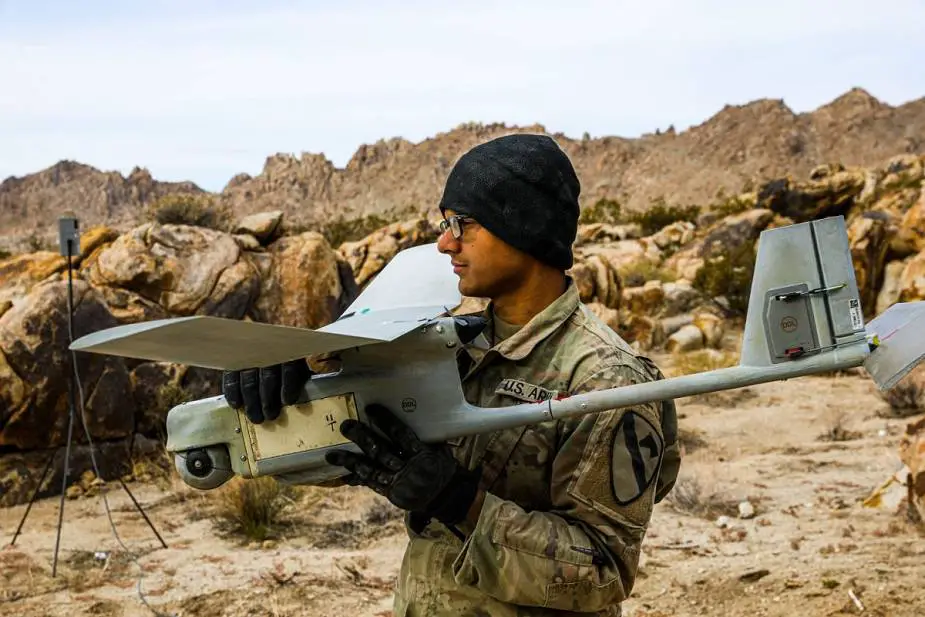US Army 1st Cavalry Division re-activates Division Cavalry DIV CAV Squadron
The 1-7 CAV was selected to serve as the Division Cavalry Squadron for the division as part of modernizing and reorganizing U.S. Army forces in support of large scale combat operations. 1-7 CAV stands for 1st Battalion, 7th Cavalry Regiment, which is a unit in the United States Army. The unit is currently based at Fort Hood, Texas, and is part of the 1st Armored Brigade Combat Team, 1st Cavalry Division.
Follow Army Recognition on Google News at this link

A U.S. soldier from the 1st Squadron, 7th Cavalry Regiment, 1st Cavalry Division tests an unmanned aerial system during Project Convergence 2022, which ran from Sept. 29 through Oct. 9, 2022. The 1-7 CAV was selected to serve as the Division Cavalry Squadron for the division as part of modernizing and reorganizing U.S. Army forces in support of large-scale combat operations. (Picture source U.S. Army)
1st CAV Division leaders assessed multiple courses of action based on the availability of existing units and selected the storied 1st Squadron, 7th Cavalry Regiment, also known as, “GARRYOWEN” to lead the pilot program and serve as the division’s cavalry squadron or DIV CAV. Prior to modularity in the mid-2000’s the Squadron served as the DIV CAV, so this is a return to the Squadron’s traditional role within the division.
“Reactivating the Division Cavalry Squadron gives the division commander a purpose-built, all-weather formation to shape the battlefield,” Speakes said. “Right now, the division has surveillance assets it can use to observe the battlefield, but these assets don’t really shape the battlefield and set conditions for successful operations the same way an Armored Cavalry Squadron can, which is the fundamental purpose for Cavalry.”
The 1-7 CAV can affect multiple domains to either stimulate the environment, or determine atmospherics regarding the threat, terrain, or civilian populace. This is due in large part to the new equipment and personnel that the Squadron is incorporating into the formation including next generation robotic combat vehicles and unmanned aerial systems
Given this volatility, which is intensifying in regions such as the Middle East, Europe and East Asia where air/ground cavalry teams proved their utility in past wars, divisions must prepare to fight for information as subordinate maneuver elements or as independent joint task forces. This imperative includes organizing to conduct forceful reconnaissance and security operations against a variety of near-peer, non-state and hybrid adversaries.
“Over the past 18 months, the 1st Cavalry Division continues to modernize our equipment and adapt how we fight which will enable us to respond to emerging threats as the Army’s principal tactical warfighting formation in large scale combat operations,” said Maj. Gen. John Richardson, 1st Cavalry Division commanding general. “This modernization process not only involves fielding cutting-edge equipment, but also restructuring the formation with the addition of a division cavalry squadron and armored cavalry troops at the brigade-level, which will provide additional reconnaissance and security capabilities enabling the division and brigade commanders to maintain the advantage over any potential adversary.”
Since the pilot program kicked off, GARRYOWEN Troops have been working in an initial operating capability phase where they were afforded the opportunity to test the DIV CAV capability to serve as the eyes and ears of the division commander during several command post training exercises.
Last fall, the GARRY OWEN team was selected to participate in the Army Futures Command’s Project Convergence 2022, the largest experiment of its kind since the Louisiana Maneuvers of the 1940s. During the experiment ,1-7 CAV Troops fought across the central corridor at the National Training Center in Fort Irwin, California for 60 days while testing the latest warfighting technology including robots, radios, unmanned aerial systems, and targeting systems.
This summer, the 1-7 CAV will return to the National Training Center to further develop the DIV CAV Squadron concept. Throughout the pilot program, GARRYOWEN Troops and leaders have continued to provide feedback to U.S. Army Forces Command and the U.S. Army Training and Doctrine Command to help shape future DIV CAV Squadrons across the Army.




























